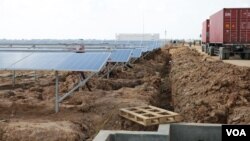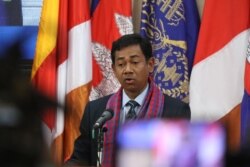The Ministry of Mines and Energy on Tuesday said it was looking to quadruple its current installed solar power output, even while continuing to invest in coal-fired plants and hydropower on smaller tributaries.
In the brief report obtained by VOA Khmer on Tuesday, the ministry is looking to invest in renewable energy, and continue ongoing investments in traditional power sources, largely in a bid to reduce the amount of energy imported from neighboring countries.
Victor Jona, a spokesperson at the Ministry of Mines and Energy, said Cambodia had decided to halt hydropower construction on mainstream Mekong River until 2030, but the possibilities of building dams on river tributaries are still being studied, such as the 190MW dam on the Sekong River in Stung Treng province.
VOA Khmer in March reported that the Energy Ministry had decided to stop dam construction on the Mekong mainstream.
“We haven’t granted any approval for building. It is in the process of studying and I can’t evaluate,” he said.
The ministry report showed nine projects underway which would increase power output by 1,500 megawatts by 2021. The plan was to quadruple the existing 90MW of solar power to 320MW in the next two years. An 80MW wind power plant was being considered at Bokor Mountain in Kampot province.
However, there are sizable investments in hydropower, coal, and heavy fuel oil power plants. Preah Sihanouk will have a 700MW power plant, and last week approved two new projects, a 700MW installation in Koh Kong province and another 265MW in Oddar Meanchey province.
Kandal province will have a 400MW heavy fuel oil power plant and a new 80MW hydropower dam in Pursat province.
The Stimson Center in the United States issued a report as the “New Evidence” revealing that a severe drought that grasped the lower Mekong Basin in 2019, was directly a result of China’s upstream dams, which restricted nearly all of the record rainfall and snowmelt from the downstream.”
Victor Jona rejected the findings, his reasoning being “China is very far from Cambodia.”
“I think the river in China is far, thousands of kilometers from Cambodia,” he said. “I think [dams] in China don’t have any impacts on Cambodia since it is very far.”
According to a report of Cambodia’s annual energy output of 3,382 MW, 33 percent was generated from hydropower dams, 33 percent through coal-fired plants, 25 percent in imports from Thailand, Vietnam, and Laos, 7 percent from biomass and 1.3 percent with renewable energy.








